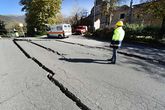Difference between revisions of "IS428 AY2019-20T1 Assign Lee Jenny Csm"
| Line 1: | Line 1: | ||
<div style=background:#34495E border:#A3BFB1> | <div style=background:#34495E border:#A3BFB1> | ||
[[File:MC1-2019.jpg|165px]] | [[File:MC1-2019.jpg|165px]] | ||
| − | <b><font size = 5; color="#FBFCFC"; font-family: "Times New Roman" | + | <b><font size = 5; color="#FBFCFC"; font-family: "Times New Roman"> VAST Challenge MC1 - Crowdsourcing for Situational Awareness </font></b> |
</div> | </div> | ||
Revision as of 12:42, 3 October 2019
Contents
Background
St. Himark has been hit by an earthquake, leaving officials scrambling to determine the extent of the damage and dispatch limited resources to the areas in most need. They quickly receive seismic readings and use those for an initial deployment but realize they need more information to make sure they have a realistic understanding of the true conditions throughout the city.
In a prescient move of community engagement, the city had released a new damage reporting mobile application shortly before the earthquake. This app allows citizens to provide more timely information to the city to help them understand damage and prioritize their response. With emergency services stretched thin, officials are relying on citizens to provide them with much needed information about the effects of the quake to help focus recovery efforts.
Objectives & Tasks
With the huge amount of information provided by the citizens, emergency planners are unable to gather insights and discover patterns without any visualization tools. Hence, there is a need to help the emergency planners build an interactive data visualization that allows them to efficiently gather information that they need and identify areas of concern. The interactive visualization aims to provide emergency planners with the following information:
- Decide how responses will change based on damage reports from citizens on the ground
- Prioritize neighborhoods based on responses given
- Region that experience the hardest hit
- Reliability of neighborhoods reports
- Changes in the number of reports, damage rate and shake intensity over time
Data analysis & Transformation Process
Dataset Import Structure and Process
Interactive Visualization/Dashboard Design
The interactive visualization can be accessed here: xxx
The resolution of this interactive visualization is set at the size of 1000 x 800. To get a clear view of the visualization, adjust your screen resolution to the dimension mentioned above.
Throughout all the different dashboards, useful guides/tips are provided to help users navigate through the different filters and actions so that their analysis can be performed smoothly. The following interactivity elements are also used throughout all the dashboards to maintain consistency:
| Interactive Technique | Rationale | Brief Implementation Steps |
|---|---|---|
Image here |
|
Home Dashboard
A homepage is created with 3 main categories in mind:
- Damage Reports: Damage Reports by citizens on the ground
- Uncertainty: Uncertainty in data and reliability of reports
- Changes overtime: Changes in conditions (damage and shake intensity) overtime
Each of these categories are further broken down into its respective sub-categories for the ease of users to perform their analysis. As such, users can select any of the above categories to gather valuable patterns and insights.
| Insights | Visualization |
|---|---|
Observations and Insights
Using the interactive visualization as a platform for reporting and analysis, the following aims to provide answers to the questions posed.
Question 1
How responses of emergency responders should change.
xxx
Prioritizing neighborhoods based on responses.
xxx
Regions that experience the hardest hit.
xxx
Question 2
Reliability of neighborhood reports.
xxx
Question 3
Changes in Reports over time.
xxx
Changes in Damage over time.
xxx
Changes in Shake Intensity over time.
xxx
